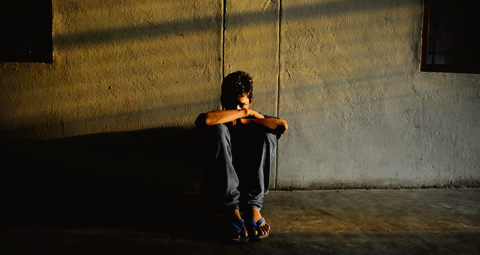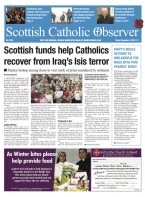August 24 | ![]() 0 COMMENTS
0 COMMENTS ![]() print
print

The Catholics fighting human trafficking
In a special report, JOANNA MAGOUFAKIS looks into the horrific reality of human trafficking, and reveals what the Church is doing to eradicate it — By JOANNA MAGOUFAKIS
If I say human trafficking, it is likely that you will think about distant countries with high poverty levels. Although this is one side of the story, the shocking truth is that human trafficking victims are here in the UK, living among us. Chances are that you have met a victim without even realising.
UK, Albanian and Vietnamese nationals are, according to the National Crime Agency’s annual report, the most commonly reported potential victims of labour exploitation, which also includes criminal exploitation. Human trafficking has become the second most profitable criminal enterprise after the illegal arms trade.
Pope Francis described human trafficking as ‘an open wound on the body of contemporary society,’ and the Vatican is helping combat it via the Santa Marta Group. The body, organised by the Bishop’s Conference of England and Wales, is an alliance of international police chiefs and bishops worldwide who are passionate about eradicating human trafficking.
The Santa Marta group has spoken to victims of human trafficking who shared their stories with them so that people better understand the agonising reality of the victims. Sophie Hayes—not her real name—told the group how her shoulder blade was broken by a trafficker. “I had to let it heal by itself and carry on. I had to go to work every single night. Sometimes I had 25 clients on one night,” she said.
Sophie was repeatedly beaten up, force-fed and turned into a money-making commodity.
Diane Martin was sexually exploited in her late teens. In her testimony she explained how her exploitation included ‘high-end’ prostitution in London. She was later trafficked to other countries. “When the people buying you are famous, in government, civil servants, members of other countries’ governments or have diplomatic immunity you don’t have any confidence that you would be believed or protected if you reported violence or rape. To be honest in those days I don’t think anyone would’ve even made a connection that a prostitute could be raped,” she told Santa Marta.
“I was always looking at people’s faces for help and I was hoping that people would be able to see behind the facade that was created. Nobody wanted to see! Nobody wanted to ask those questions because what would that then say about them? They would have to face the reality of what they’re involved in.”
Both women, in common with many trafficking victims, were young and vulnerable. Through skilled grooming methods these women were drawn into a world of violence and exploitation. They have had to learn how to live with the trauma. Diane said that she still feels an underlying fear of the physical strength of men. However, both women decided to share their stories to raise awareness of the problem.
Mgr Janusz Urbanczyk, the permanent representative of the Holy See to the Organisation for Security and Co-operation in Europe (OSCE), spoke at a recent conference on trafficking and highlighted that ‘everyone has a role’ and that the best way forward is ‘making a difference together.’
Mgr Urbanczyk said: “The attempts made to fight human trafficking and its deleterious consequences on adults and minors, as well as on the human and cultural fabric of different societies, despite some positive results, are still insufficient to adequately counteract this phenomenon. Much still remains to be done also to increase awareness of the problem, its magnitude and connections.”
He emphasised the important role of the Catholic Church and specifically highlighted the various forms of action it takes.
“The Catholic Church, through its various forms of concrete presence, intends to take action in every phase of the fight against trafficking, in order to protect every human being from fraud, to free them from exploitation and slavery, and to assist all the victims of this horrific crime.”
Mgr Urbanczyk explained that the trafficked tend to trust the Church more than law enforcement.
“Experience has shown that many victims are wary of trusting law enforcement authorities, and they confide their stories more easily with religious people, who can build up their trust for the legal process and provide them safe haven and other forms of assistance,” he said.
“That is the work of many Catholic institutions and organisations, often on the front line in helping the victims, especially women and girls, to escape from the situation of slavery to gain true personal and social rehabilitation and freedom.”
The monsignor’s comments were recently echoed by Bishop Brian McGee of Argyll and the Isles Diocese. As the SCO revealed in June, the Church has formed a partnership with the Scottish Government and Police Scotland to combat the problem.
“One thing the Church can do domestically is to influence the choices people make, for example to get them to think about the nail bar or car wash and ask why it so cheap compared to the one around the corner,” the bishop said. “But also, people are trafficked because they are living in poverty or war—that is one thing government can have an influence on.
“Human trafficking exists because the place of origin is poverty and war, and the place of destination is greed. We need to tackle both of these.”
The Scottish Government launched a consultation last year on human trafficking, which revealed the extent of the problem here. The report showed that people are often trafficked to Glasgow and forced into prostitution and poorly paid labour. The victims often live in overcrowded flats with no access to the outside world apart.
Robert, from Eastern Europe, was promised a job in a building site in Glasgow. Instead he was made to distribute leaflets on the streets for up to 12 hours. He was beaten up in the flat by the people in charge and was not permitted to leave for any other reason than to work. When Robert was out working he was made to wear a GPS tracking device. Thankfully, Robert was able to hide his mobile phone and contacted the police. Others are not so lucky.
Another case study reveals the hardship of Roma woman Jaroslava, who was lured into prostitution.
“I thought that I would be working in a sandwich factory and that they would provide me with somewhere to stay. My friend told me that this would cost a small amount of money to arrange but that I could pay him back a little each month from my wages,” she said.
Instead of what was promised, Jaroslava was abused. “He told me I was naive to think I could get a job in the UK and surely I must have known that I was going to work in a brothel.
“I started to cry and became very scared. I was still saying that I wouldn’t do it when he slapped me and raped me saying that this was what I deserved, that I’d better get used to it and that this is what he would do if I ever disobeyed him again.”
Luckily, Jaroslava managed to escape and received help from Trafficking Awareness Raising Alliance (TARA), a support service for trafficking survivors established in 2004 by Community Safety Glasgow.
An intelligence-led police operation investigating the human trafficking of persons within the United Kingdom for the purposes of sexual exploitation shed some light on how perpetrators work. Different premises in Glasgow, Aberdeen, Belfast and Cardiff were used as brothels and attracted local clientele. The people alleged to have been behind the running of the brothels were caught and charged.
Through the work of parishes and groups like Santa Marta, Catholics can help combat the horrors of human trafficking. And the victims are full of appreciation for their efforts, and for the support of the Holy Father.
Sophie Hayes said: “Rehabilitation is a journey and what I have learned is that you can’t do this alone. You need organisations who understand the issue and want to help and provide that support and a safe place.
“Having Pope Francis speak about this issue is incredible. A figure and a leader such as him to really shine the spotlight on the issue of human trafficking is exceptional.”
In an address to the Santa Marta group, Diane Martin, who was sexually exploited as a young girl, said: “The woman I am today is very grateful for your commitment to this important work and the girl who was in her late teens hoping to be seen, hoping for someone to ask the right questions and hoping for a way out receives a little bit more healing because of that.”
Scottish charity takes on human trafficking
In India 20,000 people are trafficked each year; half of them are children. 77 per cent are girls. Some end up in the sex trade while others work in inhumane conditions, often in a domestic environment. 33 per cent are taken across the border to Nepal and further away.
Scotland’s Catholic aid agency SCIAF is trying to change these awful statistics through preventive work.
“Our workers visit poor villages and inform people about traffickers: how they work and how to spot the signs. We also give talks on the Nepalese border where we have set up interception points,” said Val Morgan, who recently visited India in his role as communications officer for SCIAF.
“ We educate people working on bus and railway stations. Often people who are trafficked are taken far from their homes through public transport. By making them aware of the signs we can hopefully rescue more people.”
In India, many traffickers are people known to vulnerable families. In some cases they are related to the victim. These people promise families that their children will receive an education and a brighter future. In reality they are being exploited in the sex trade, domestic servitude, manual labour and organ harvesting.
Poverty is the root of the problem and SCIAF is trying to help poor families out by teaching them how to sustain themselves.
“We teach families how to grow things and how to start a business that can provide them with a decent income. We also work with other organisation such as Caritas India who help us a lot in this work,” Mr Morgan said.
SCIAF and organisations they are partnered with work closely with the police and other authorities in the country. This has led to positive outcomes.
“Some victims have been rescued and reunited with their families, others have been taken in by centres who specialise in helping vulnerable people. We believe that even more people can be rescued in the future,” Mr Morgan added.










